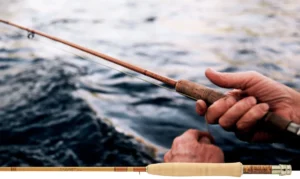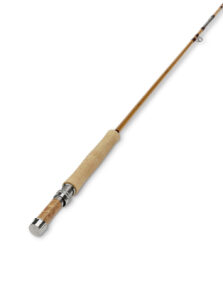
“Gorilla Glue, 9/2014, by Mike Mozart of …” from www.flickr.com and used with no modifications.
Key Takeaways
-
Understanding different glue types is essential for bamboo fly rod construction and repair.
-
Epoxy and polyurethane glues offer advantages in strength and water resistance.
-
Proper glue application is key to a strong and lasting bond.
-
Seeking professional help may be advisable for complex bamboo rod repairs.
When it comes to the art of building, repairing, and restoring bamboo fly rods, the adhesive you choose is as crucial as the bamboo itself. The right glue can make all the difference in creating a rod that’s both durable and has the perfect flex for those tight loops and delicate presentations we all strive for.
Glue Options for Bamboo Fly Rod Crafting
Bamboo fly rods are a blend of natural beauty and precise engineering. To begin, let’s dive into the world of adhesives that are suitable for these fine instruments. There are several types of glues used in the crafting and restoration of bamboo fly rods, each with its unique properties.
Traditional Hide Glues vs. Modern Adhesives
In the past, hide glues were the go-to for rod builders. They are natural, time-tested, and have a long history in woodworking. However, they require precise temperature control and have a limited open time, which is the period during which the glue remains workable. Today, we have modern adhesives that are more forgiving and offer greater strength and water resistance.

Advantages of Epoxy and Polyurethane Glues
Now, let’s talk about the modern heroes in the adhesive world for bamboo rods: epoxy and polyurethane glues. These glues have gained popularity for good reason:
-
Epoxy is renowned for its incredible strength and its ability to fill gaps, making it ideal for snugly fitting bamboo strips together.
-
Polyurethane glue expands as it cures, filling any microscopic voids between the bamboo fibers, ensuring a watertight bond.
Most importantly, both epoxy and polyurethane are waterproof, which is essential for any fishing rod that’s going to spend its life battling the elements.

Applying Glue for Maximum Bonding Strength
Whether you’re building a new rod or repairing an old friend, the key to success is in the application. Here’s how to ensure maximum bonding strength:
-
Start with clean, dry bamboo. Any dust, oils, or moisture can weaken the bond.
-
Apply the glue evenly. A thin, consistent coat is better than globs of glue that can create weak spots.
-
Clamp the bamboo strips firmly or wrap with binding thread while the glue cures. Pressure ensures a tight bond and helps any excess glue squeeze out.
Remember, patience is your ally here. Rushing the process can lead to a subpar bond that might fail when the rod is put to the test on the water.
Identifying Common Issues
Before you can fix a bamboo fly rod, you need to know what you’re up against. Common issues include delamination, where the glue between the bamboo strips begins to fail, and splits or cracks in the bamboo itself. Sometimes, it’s the hardware that needs attention, such as loose ferrules or damaged guides.
Step-by-Step Repair Process
The repair process starts with a thorough cleaning of the rod. This involves gently removing any dirt and old varnish without damaging the bamboo. Next, carefully heat the ferrules to remove them and inspect the bamboo strips for any damage.
For delamination, you’ll need to carefully pry apart the strips, clean out the old glue, and re-glue them. After the glue cures, sand the rod lightly to prepare it for a fresh coat of varnish.
Selecting the Right Glue for Repairs
Selecting the right glue for repairs is as important as the initial build. For delamination, a strong epoxy that can penetrate the bamboo fibers is ideal. For splits or cracks, a thicker epoxy or a specialized bamboo repair glue can provide the necessary strength and flexibility.
Restoring Vintage Bamboo Fly Rods
Restoring a vintage bamboo fly rod is about honoring its past and preparing it for many more years of service. It’s a delicate balance between maintaining originality and ensuring functionality.
Assessing the Rod’s Condition
First, assess the rod’s overall condition. Look for signs of wear, check the straightness of the rod, and test the action. Make a list of issues to address, including:
-
Checking for any loose or missing guides
-
Examining the ferrules for fit and function
-
Assessing the integrity of the grip and reel seat
Once you have a clear picture of the rod’s condition, you can prioritize the restoration work.
Restoration is not just about making the rod look new again; it’s about preserving its character. Use period-correct components and techniques wherever possible. For instance, if the rod originally had silk thread wraps, re-wrap with silk rather than switching to nylon.
Restoration Tools and Techniques
You’ll need a few specialized tools and materials for restoration work, including a rod wrapping jig, fine sandpaper, and the appropriate varnish. A heat gun is useful for removing old ferrules and a fine-toothed saw for making precise cuts if you need to replace a section of bamboo.
Techniques vary depending on the rod’s condition, but here are a few general tips:
-
When re-gluing splits, use a binding cord to tightly wrap the repaired area while the glue cures.
-
If you’re replacing a section of bamboo, match the taper as closely as possible to maintain the rod’s action.
-
Apply several thin coats of varnish rather than one thick coat to avoid drips and runs.
When to Seek Professional Restoration Help
If you’re faced with complex issues like severe warping or extensive damage, it might be time to seek professional help. A seasoned rod restorer will have the experience and tools to tackle big jobs without compromising the rod’s integrity.
Remember, the goal of restoration is to bring the rod back to a state of beauty and functionality. Sometimes, the best way to honor a vintage bamboo fly rod is to entrust it to the hands of a skilled craftsman.
Frequently Asked Questions (FAQ)
What is the best glue for bamboo fly rod delamination repair?
Delamination can be a tricky problem, but with the right approach, it can be solved to restore your bamboo fly rod to its former glory. The best glue for this issue is typically a high-quality epoxy. Epoxies are strong, durable, and water-resistant, making them ideal for fishing rods that will be exposed to moisture. They also have a long working time, allowing you to carefully align the bamboo strips before the glue sets.
How do I repair a vintage bamboo fly rod?
When repairing a vintage bamboo fly rod, start by carefully assessing the damage. If it’s a simple delamination, you can follow the steps previously mentioned: cleaning the area, applying epoxy, and clamping the strips until the glue cures. For more complex issues, such as cracks or breaks, you might need to splice in new pieces of bamboo. Always sand and finish the rod with a proper varnish to protect it from the elements and maintain its classic look.
Repairing a vintage bamboo fly rod often requires a delicate touch and attention to detail. If you’re unsure about any step in the process, it’s wise to consult with a professional rod builder or restorer. They can provide guidance or take on the repair to ensure your rod is returned to a fishable condition without losing its vintage charm.
What is the best glue for bamboo fly rod delamination repair?
For delamination repair, I recommend using a two-part epoxy specifically designed for woodworking or bamboo. It should have a strong bond, be waterproof, and offer a long open time for working with the materials. Some of the trusted brands among rod builders include Titebond III, which is known for its waterproof properties, and G/Flex by West System, which offers excellent flexibility and adhesion.





